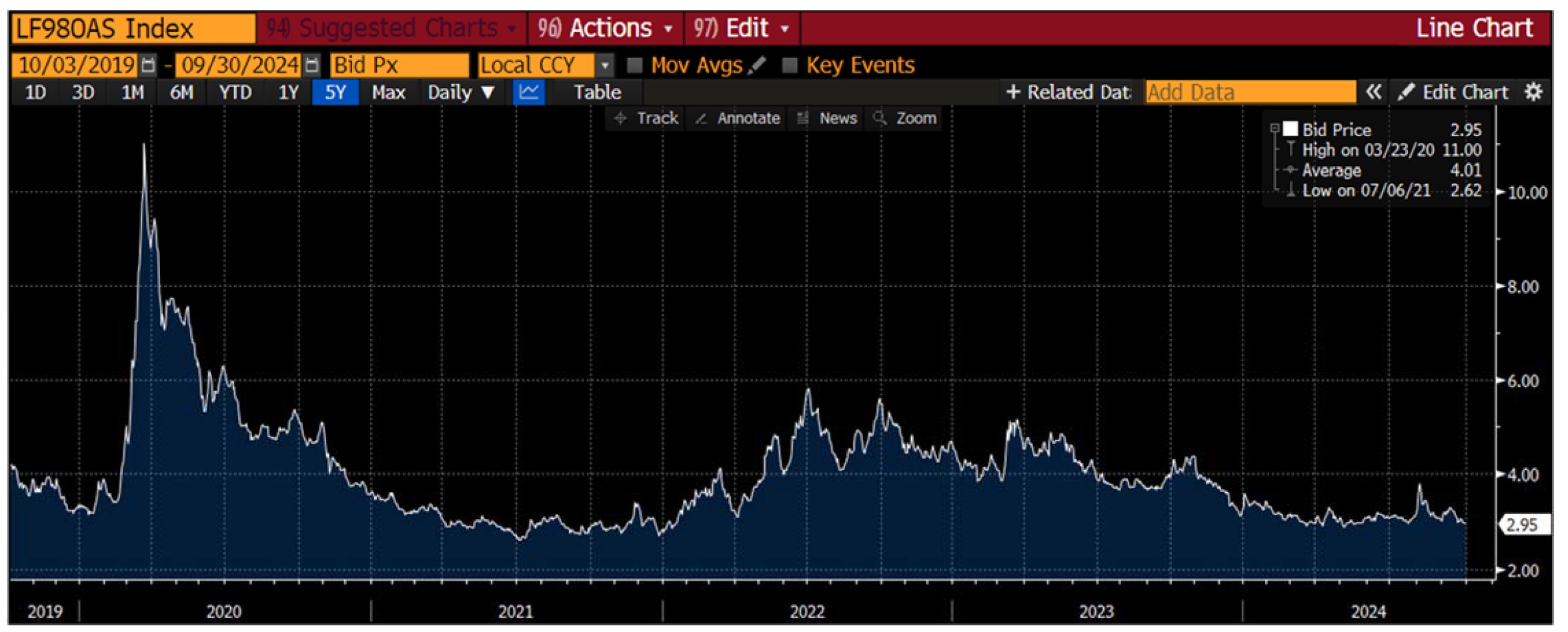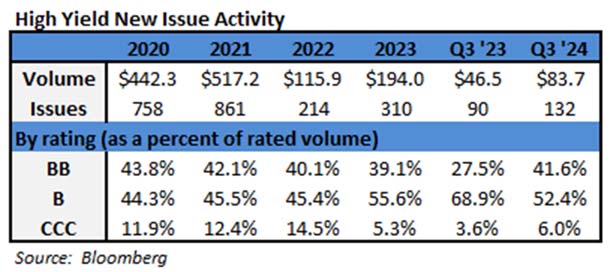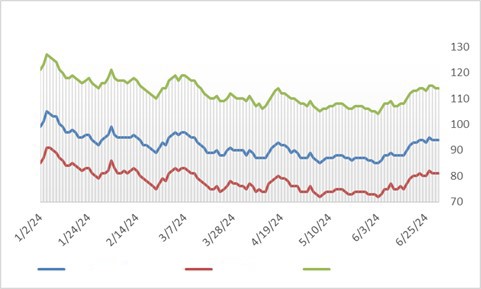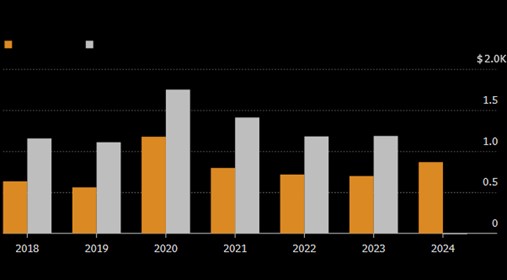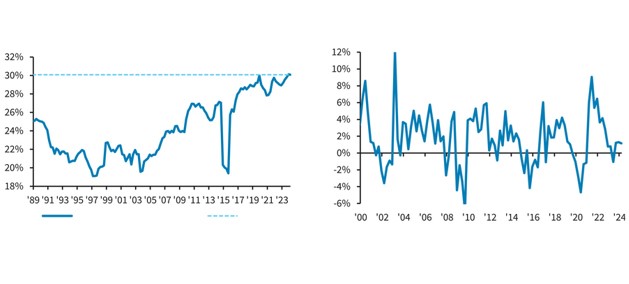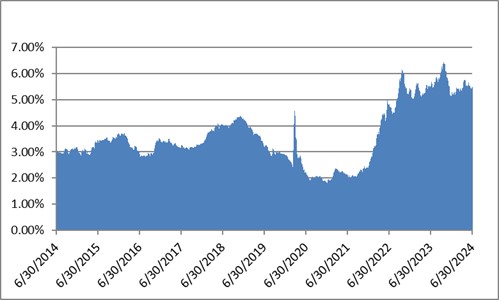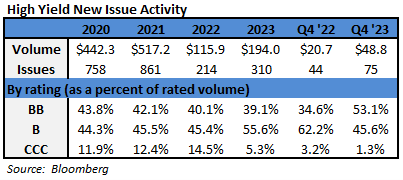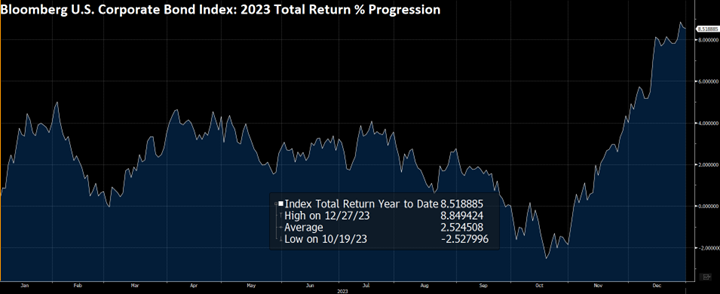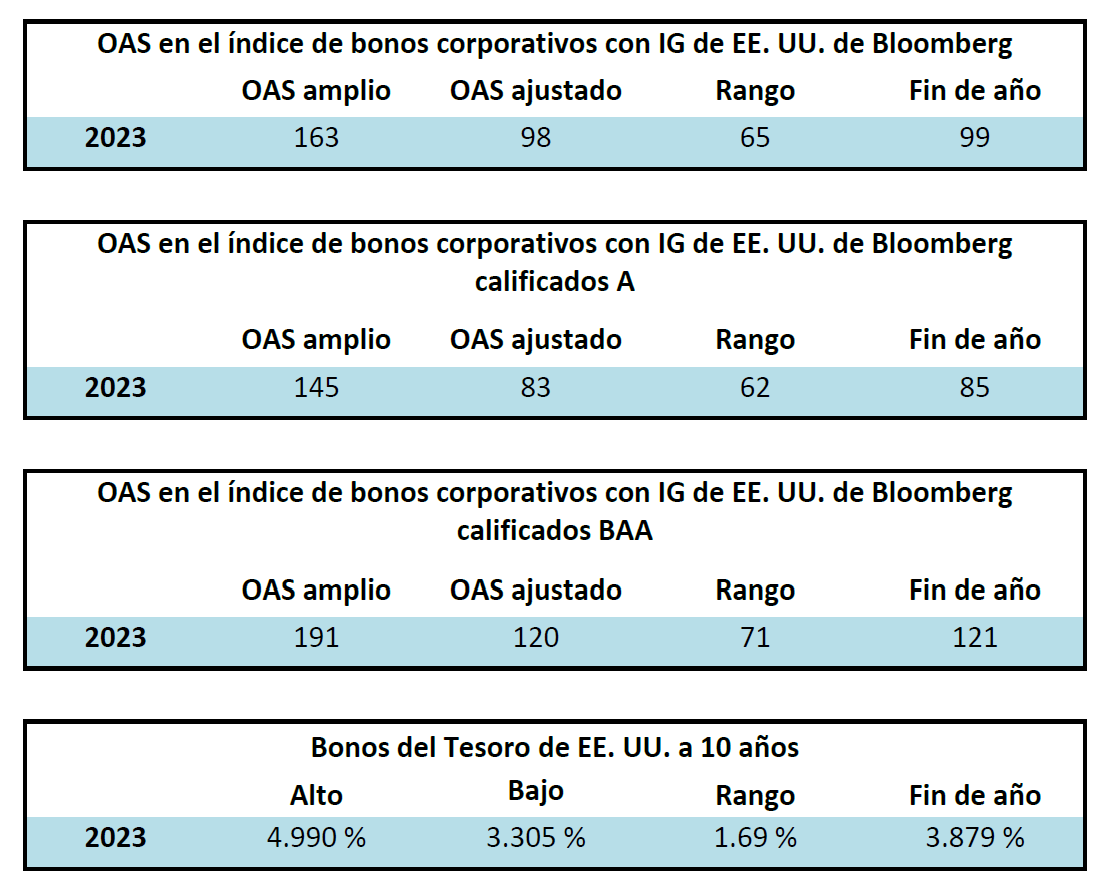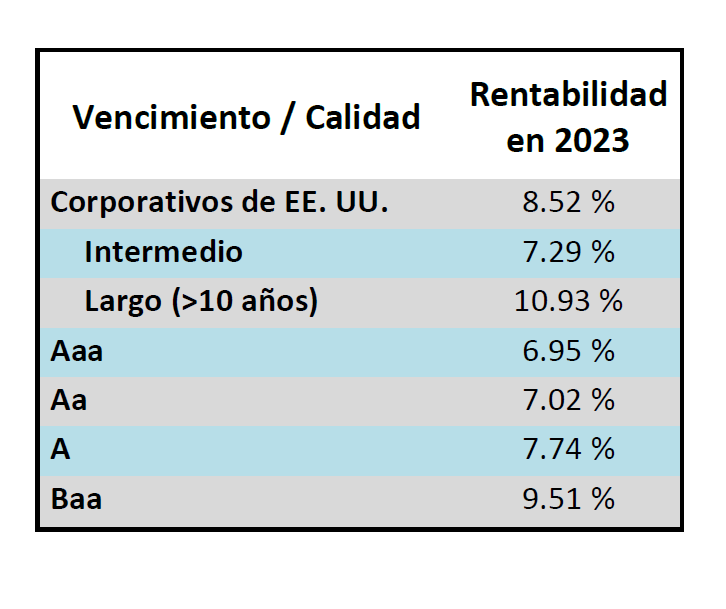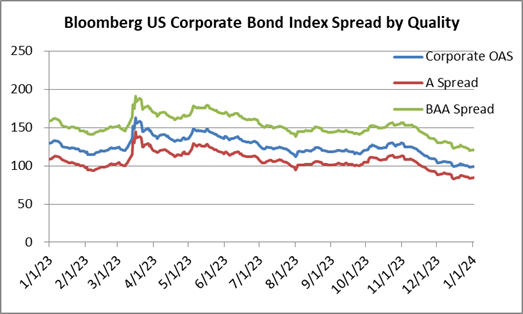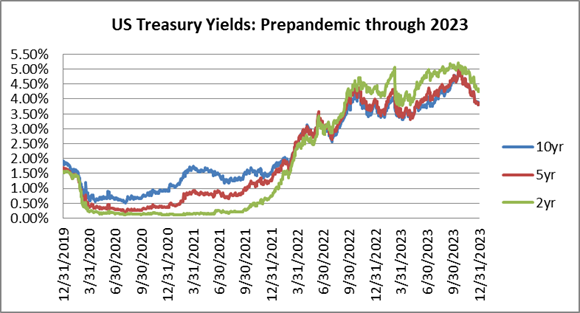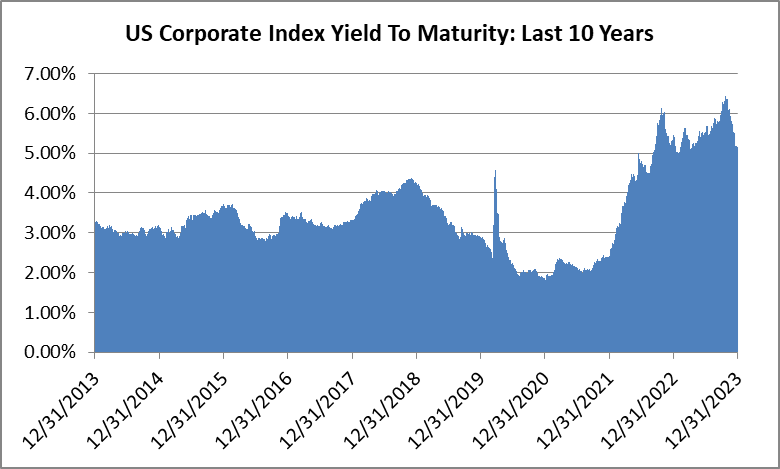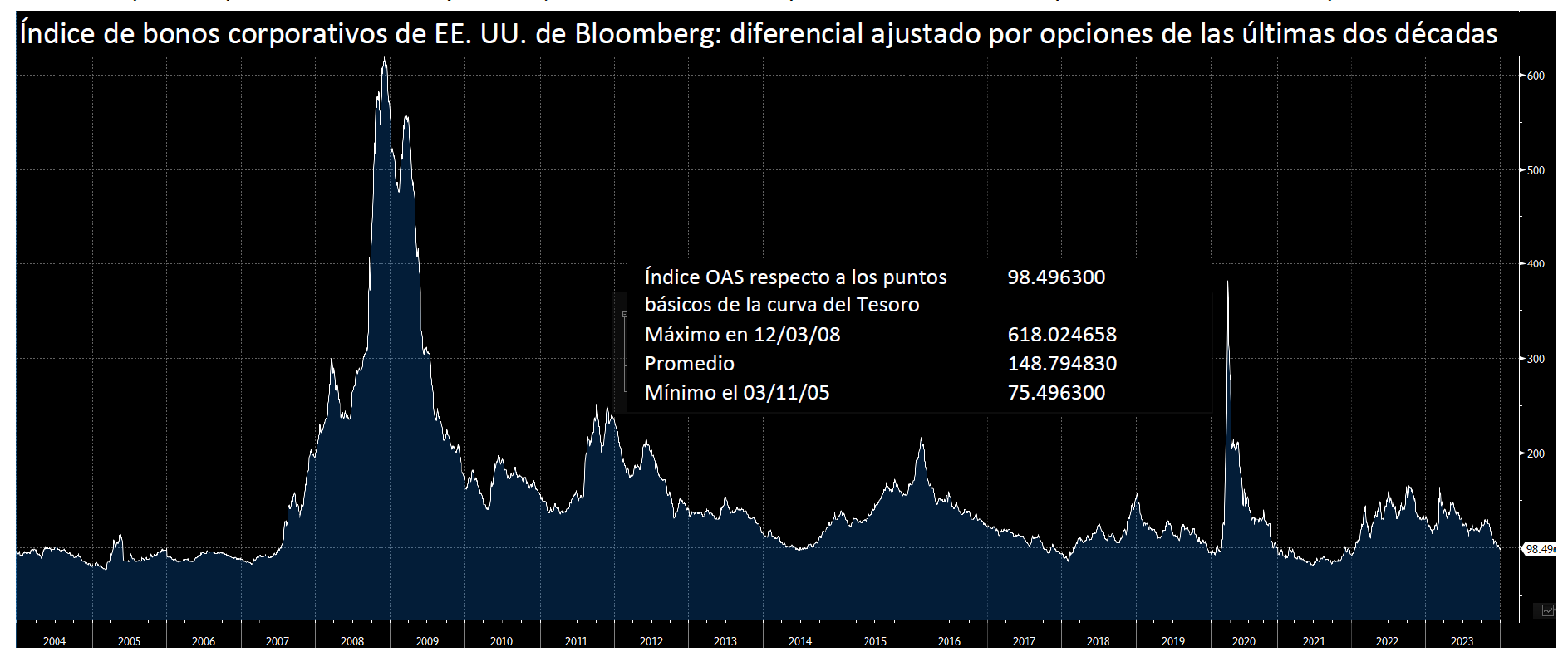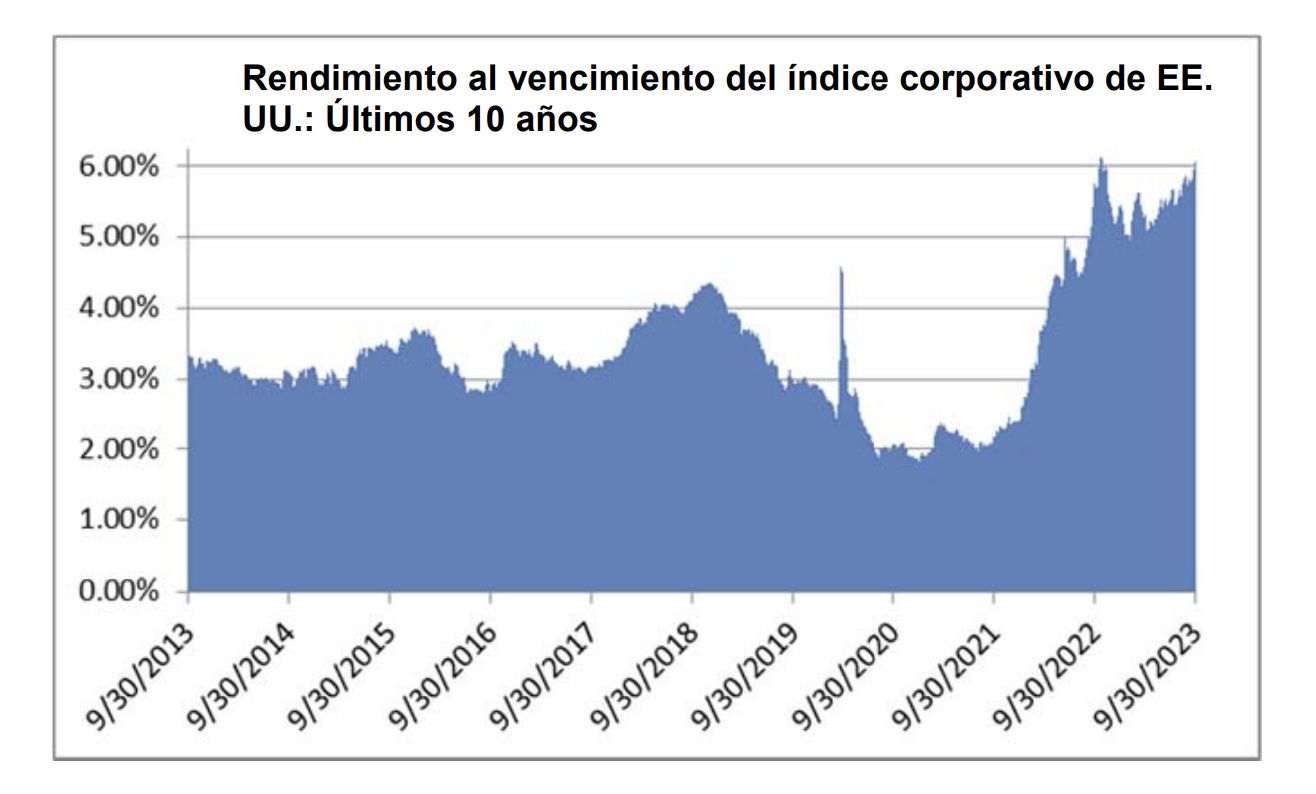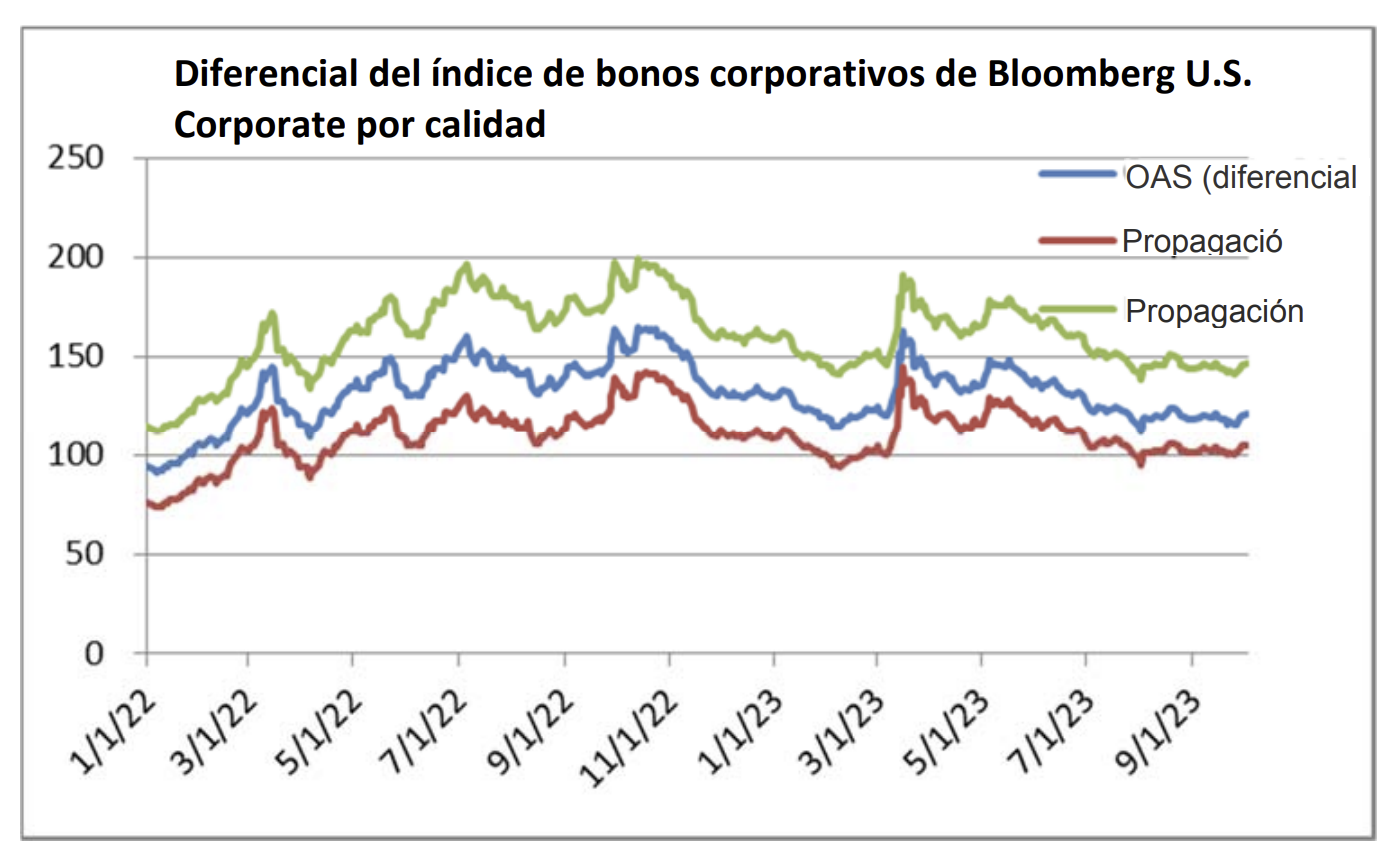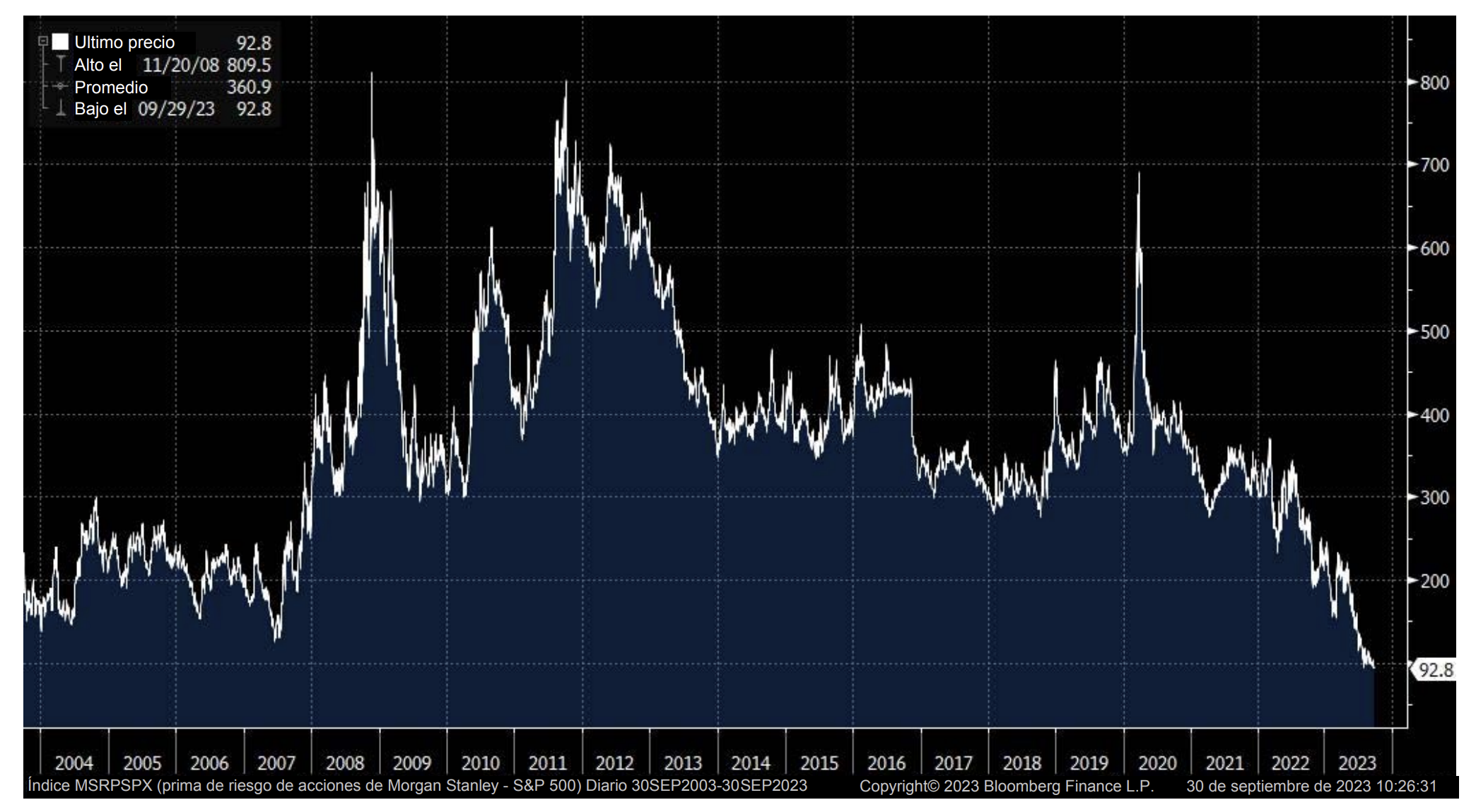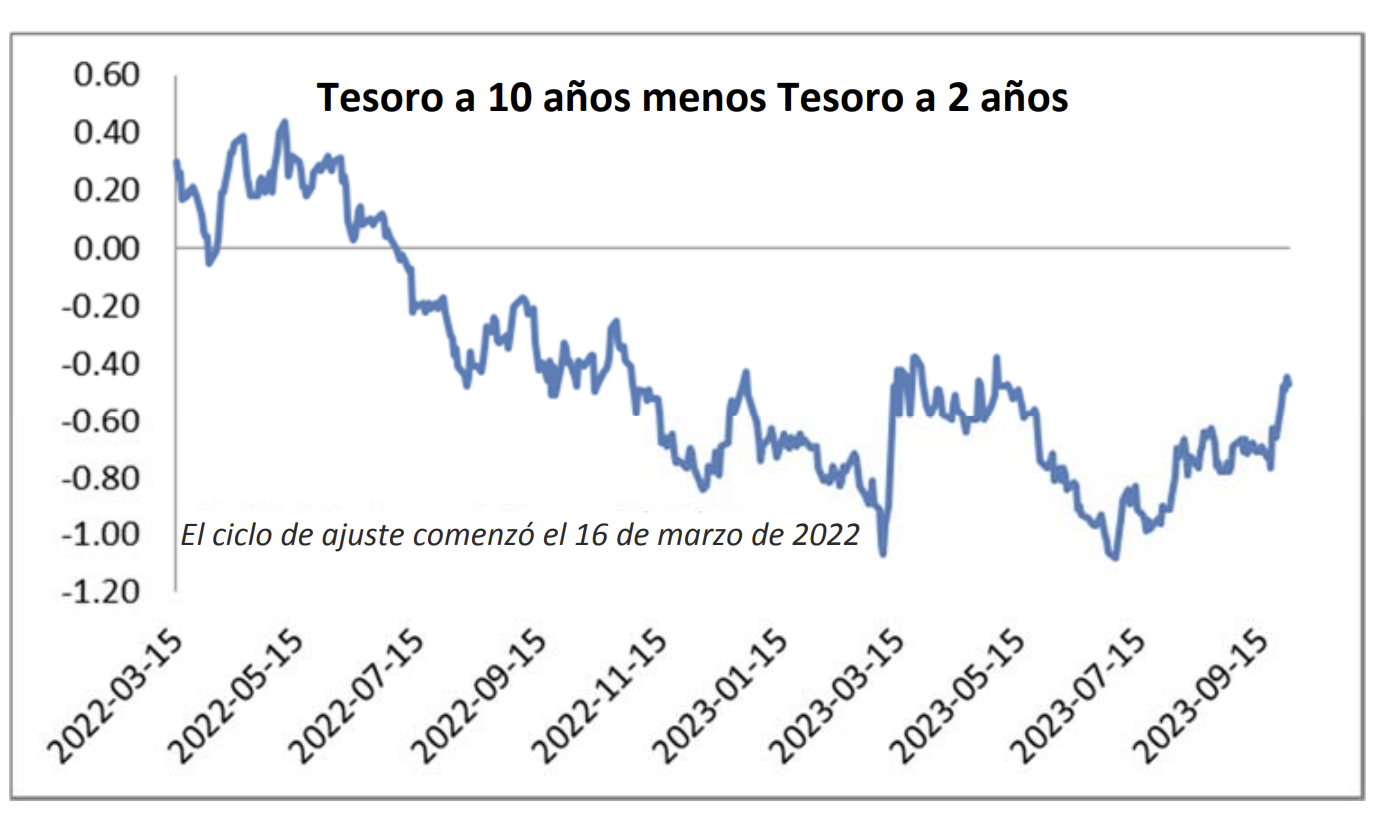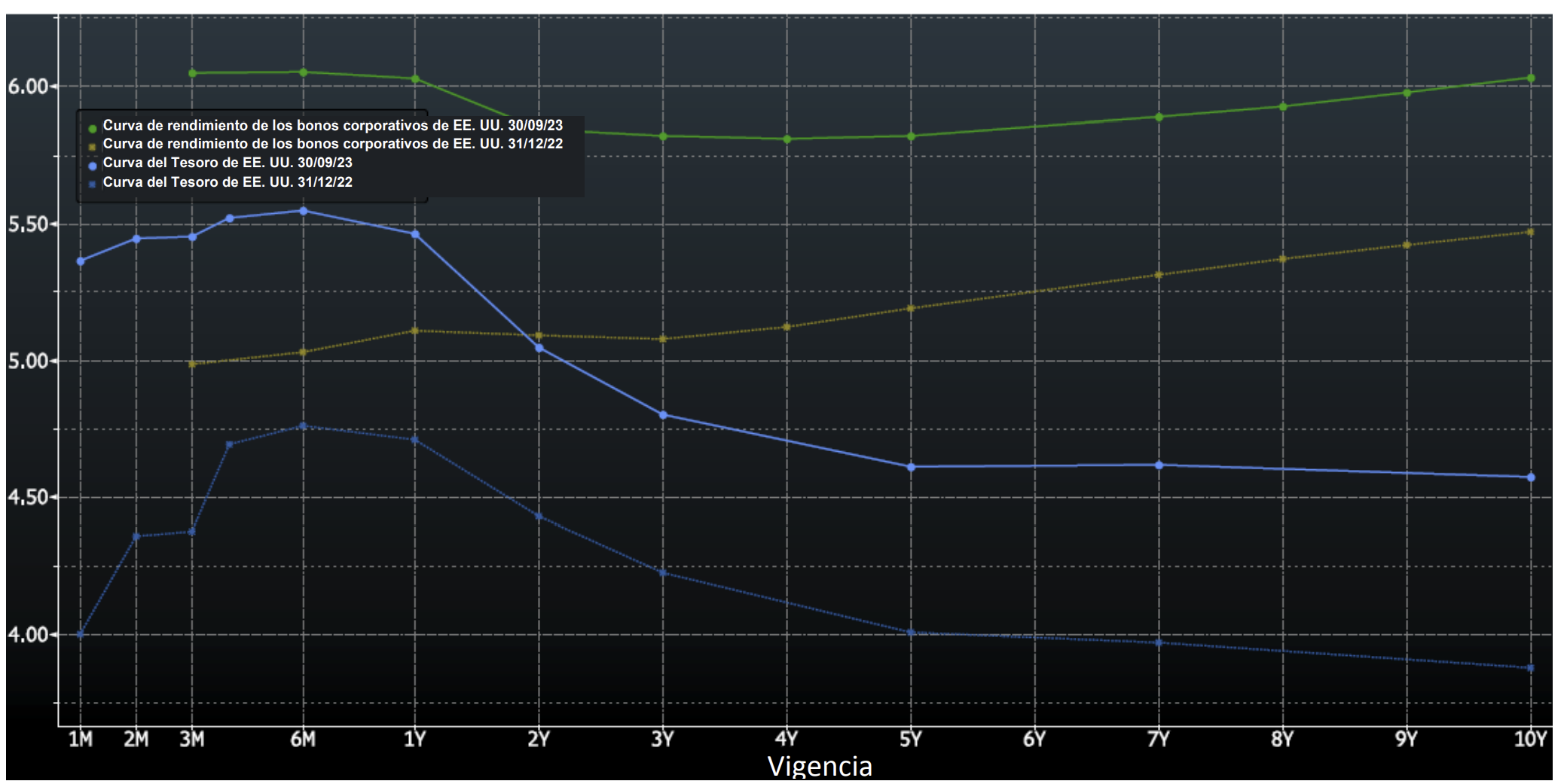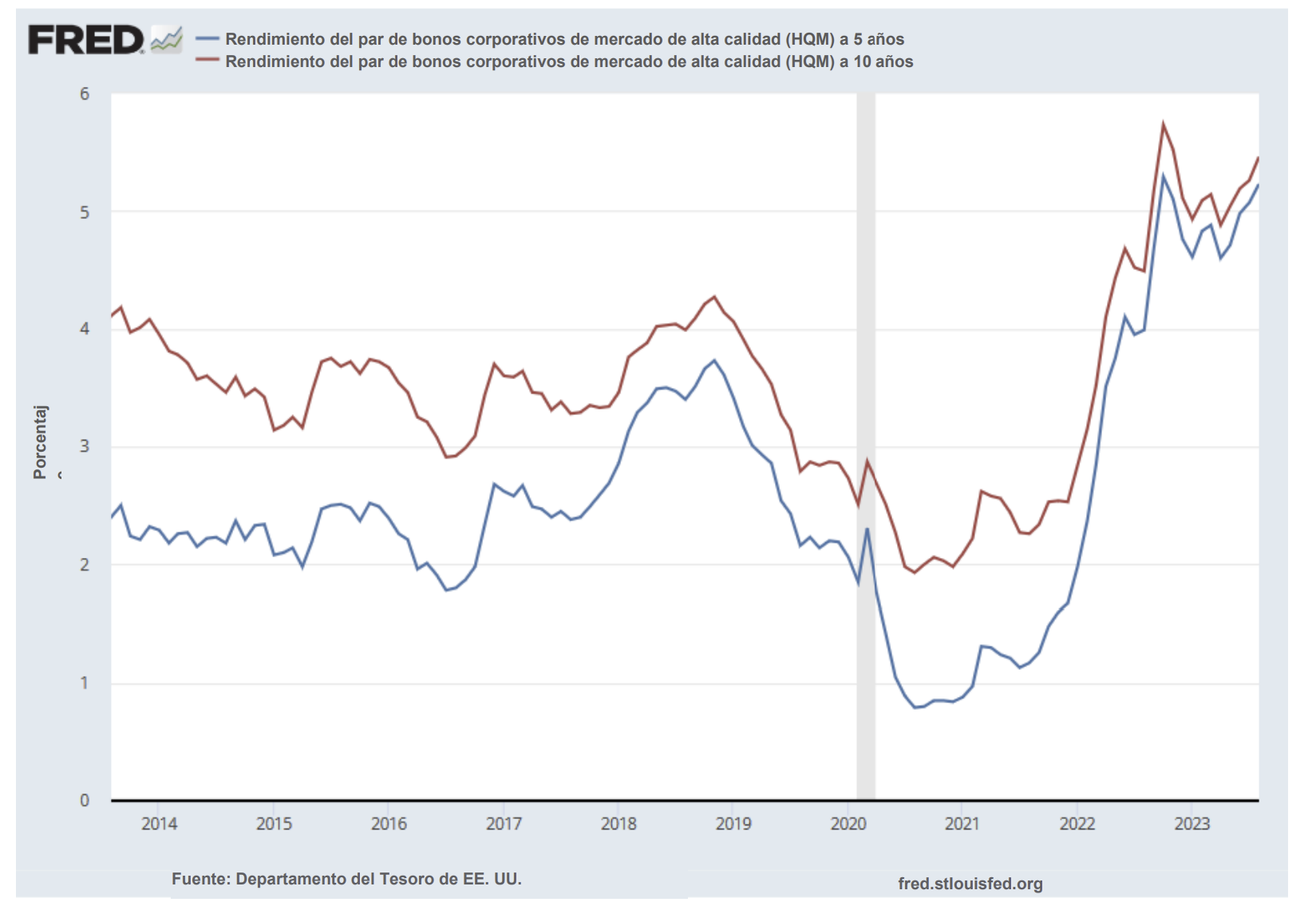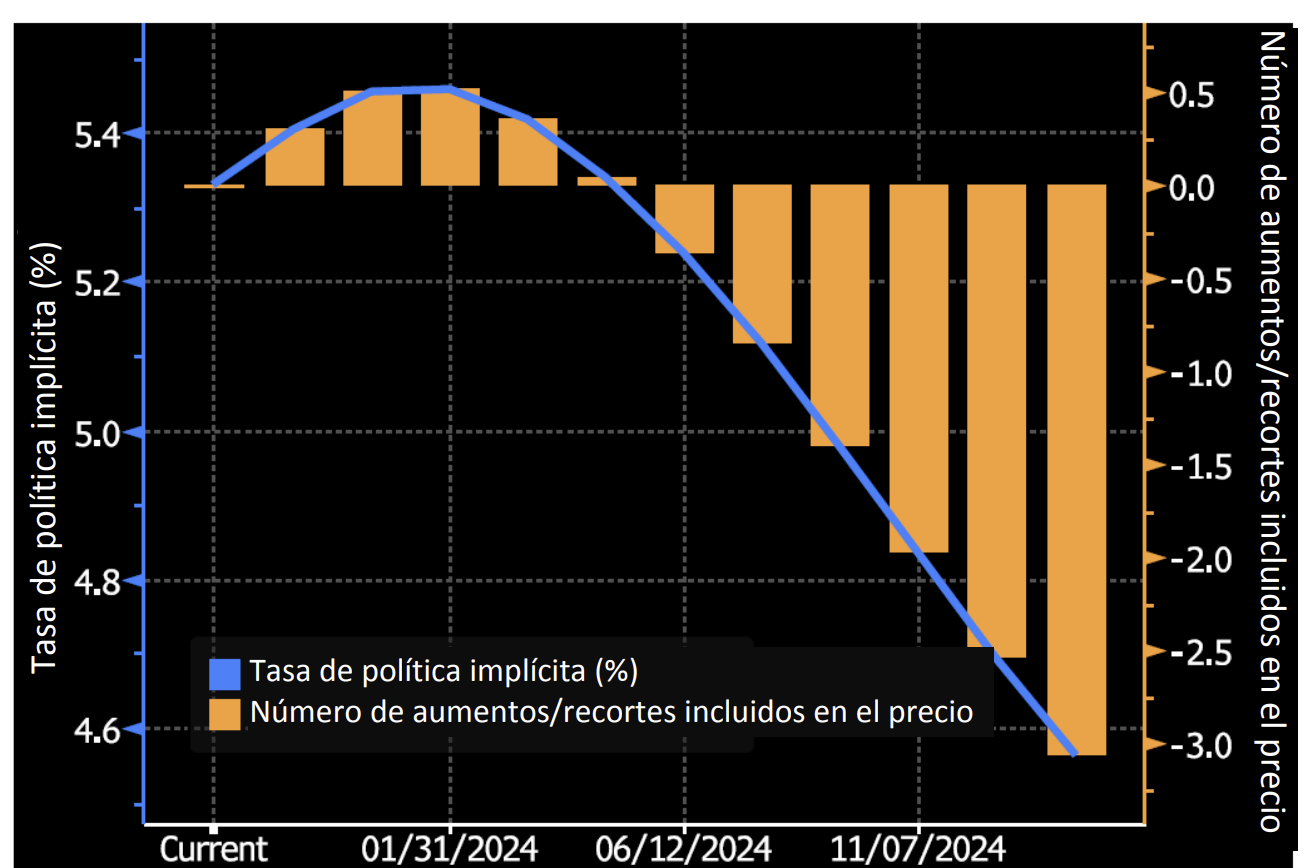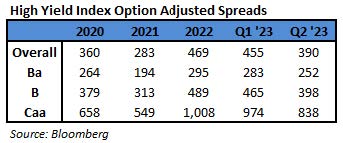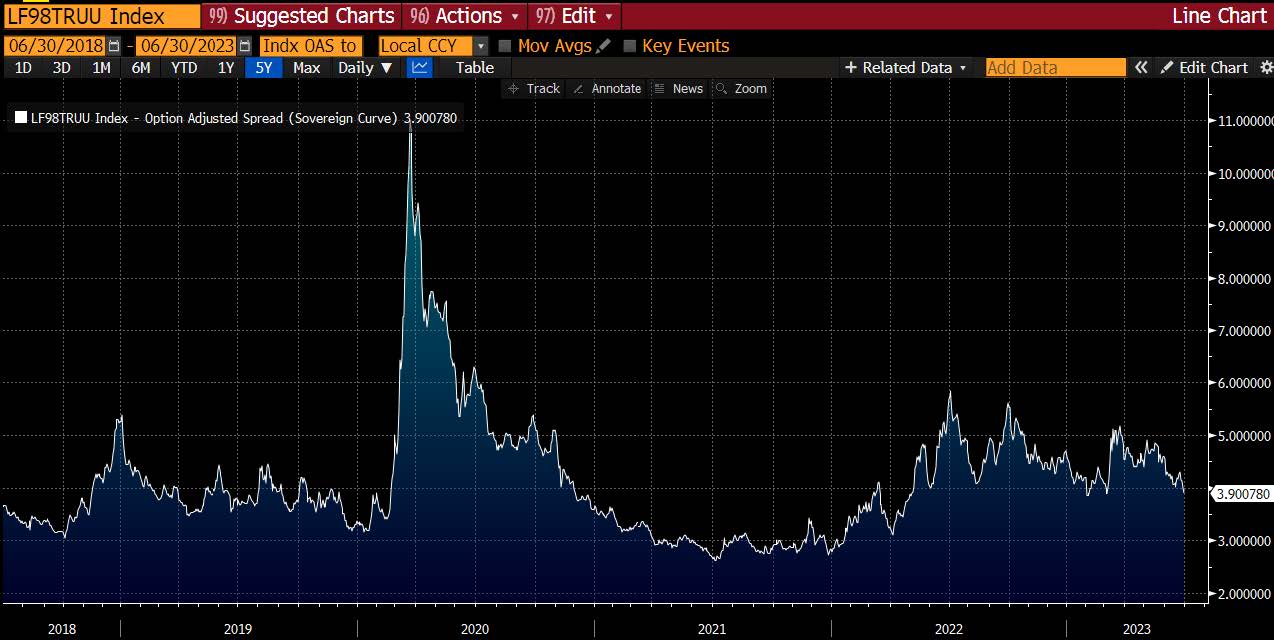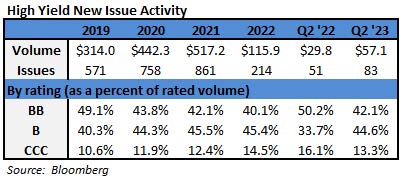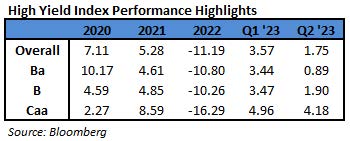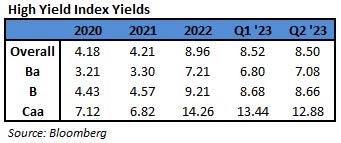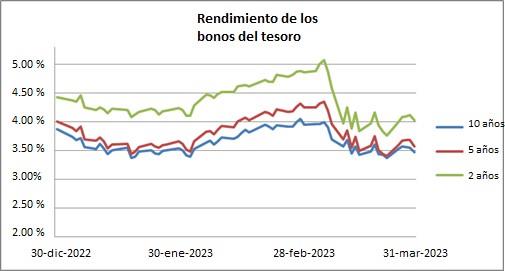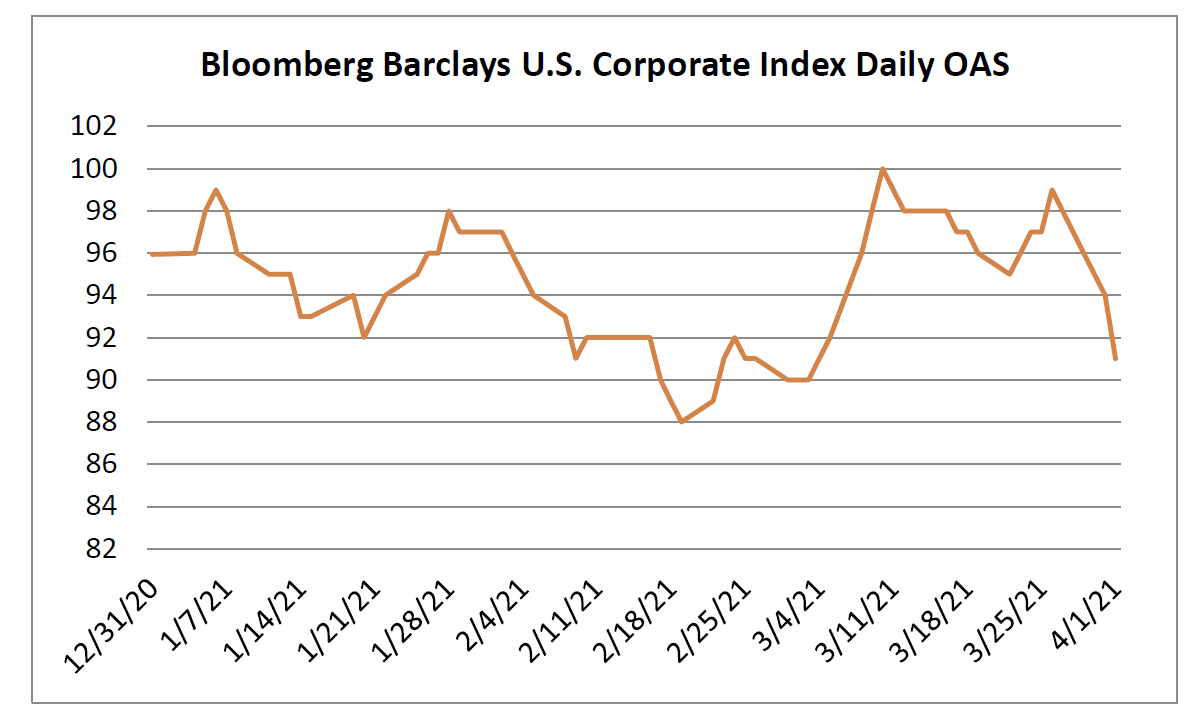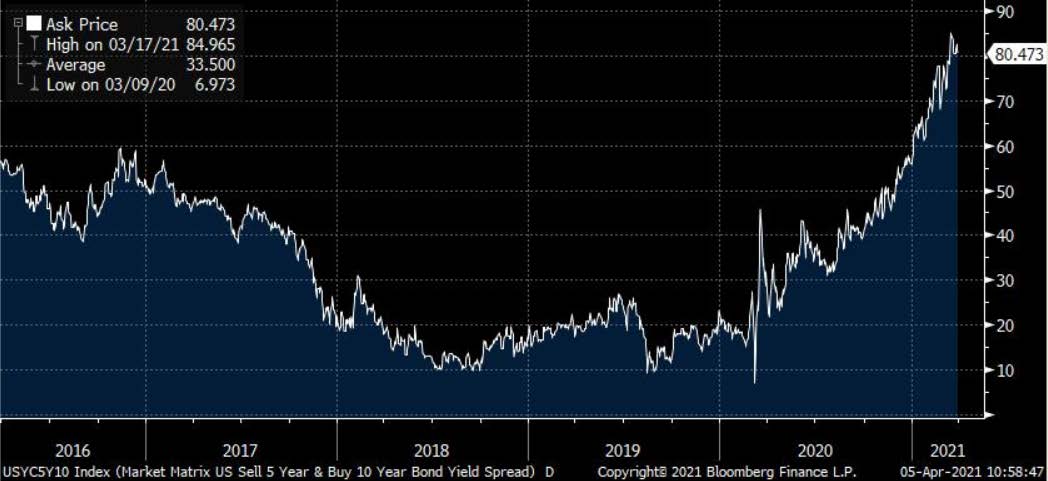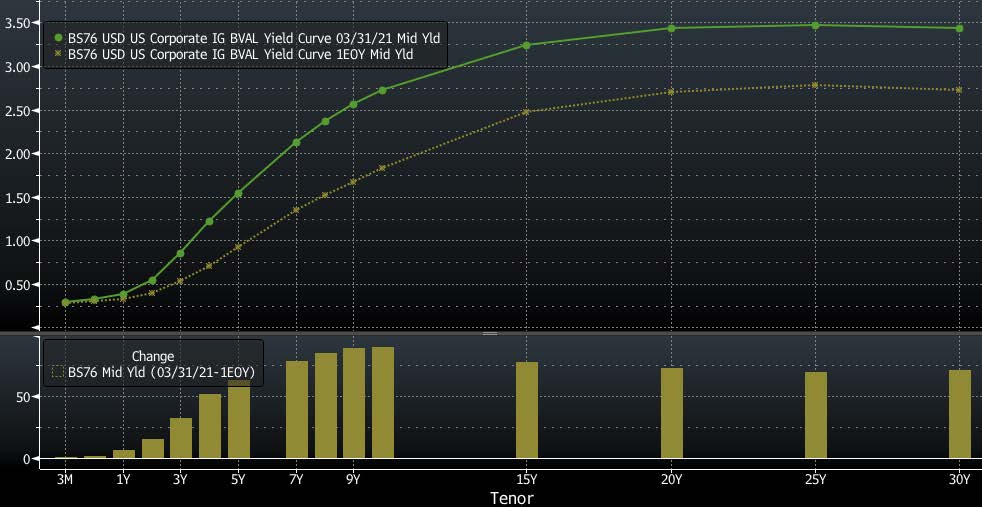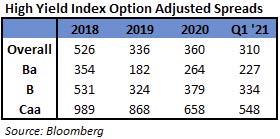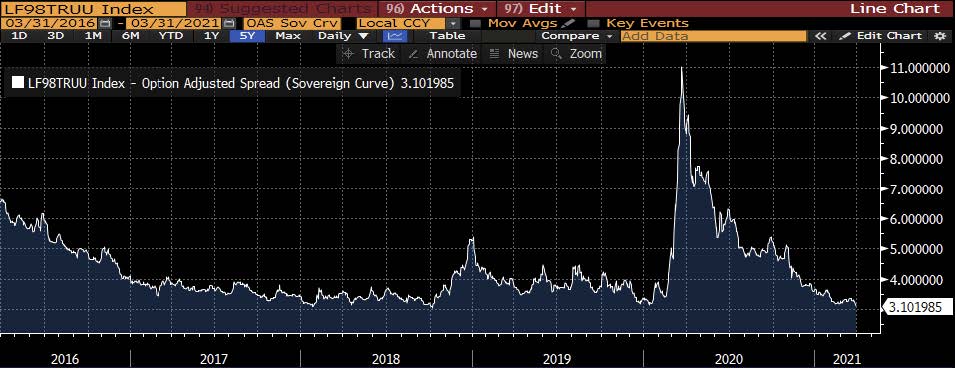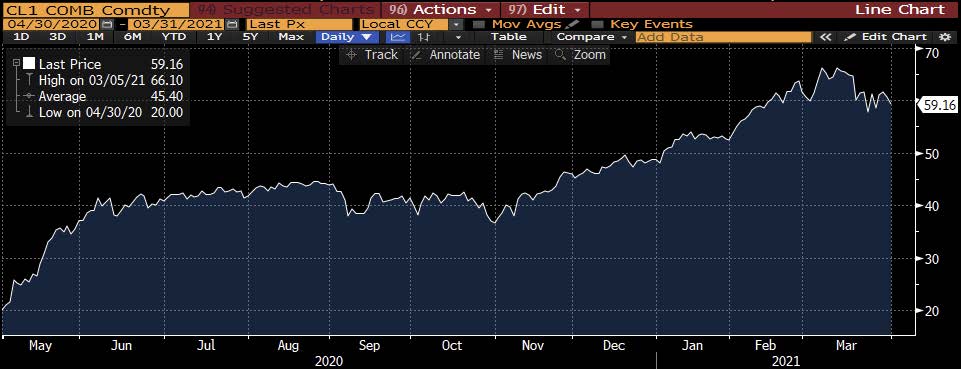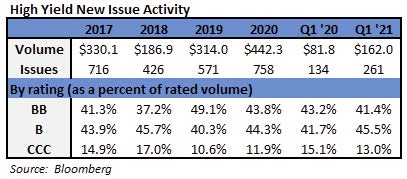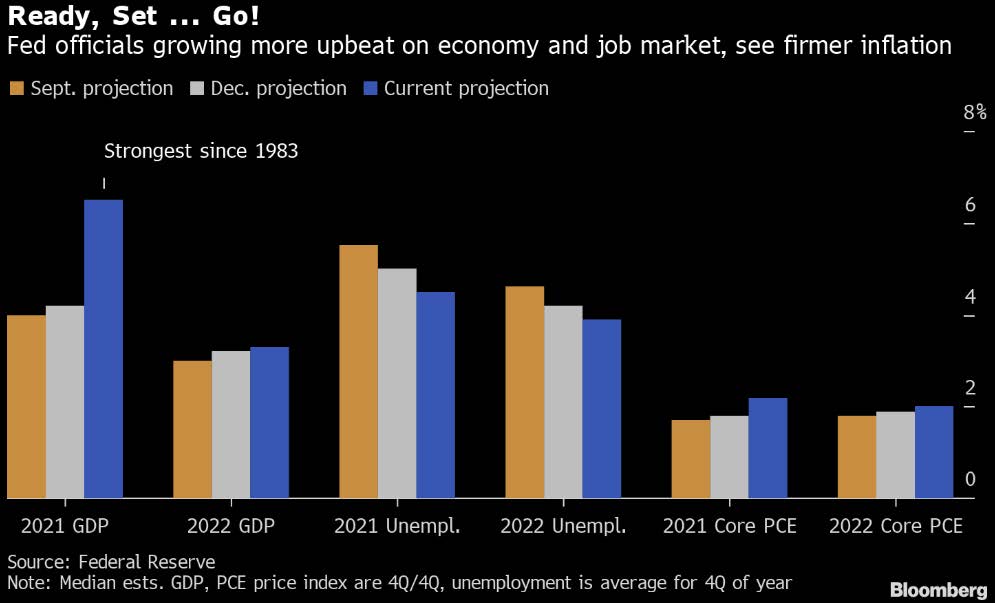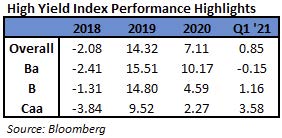El crédito con grado de inversión (en inglés IG) registró rendimiento total positivo estable a partir de 2023. Durante el primer trimestre, el diferencial ajustado por opciones (OAS) en el Índice de Bonos Corporativos de EE. UU. de Bloomberg se amplió en 8 puntos básicos y llegó a 138 después de haber comenzado el año en 130. Con diferenciales más amplios, el rendimiento positivo durante el trimestre se vio impulsado por los ingresos por cupones y un repunte en los bonos del Tesoro, con el título a 10 años cerrando el trimestre en 3.47 %, 41 puntos básicos menos en lo que va del año.
Durante el primer trimestre, este Índice registró una rentabilidad total del +3.50 %. La rentabilidad total sin comisiones del programa de grado de inversión de CAM durante el trimestre fue del +3.41 %.
El grado de inversión vuelve a estar de moda
En nuestro último comentario, escribimos que el rendimiento total del crédito con grado de inversión podría estar a punto de rebotar. El Índice Corporativo ahora ha publicado dos trimestres consecutivos con rendimiento total positivo: el cuarto trimestre de 2022 y el primer trimestre de 2023 con +3.63 % y +3.50 %, respectivamente. 2022 fue el peor año en cuanto a rentabilidad total para el credito con grado de inversión registrado (-15.76 %), y el 7 de noviembre llegó al valor más bajo desde el pun o de vista de la rentabilidad. Desde el 7 de noviembre, el Índice Corporativo ha registrado una rentabilidad total positiva del +8.89 %, lo que ilustra la rapidez con la que puede cambiar el temperamento del mercado.
Los bonos del Tesoro a corto plazo ofrecen actualmente algunos de los rendimientos más elevados de los últimos años. El bono a 2 años cerró el primer trimestre de 2023 en 4.03 % y creemos que los de corta duración son una alternativa atractiva frente al efectivo. Aunque las tasas de corto plazo pueden resultar atractivas para colocar algo de efectivo, no creemos que sean un sustituto adecuado para una cartera de bonos corporativos de mediano plazo para la mayoría de los inversores, debido al alto grado de riesgo de reinversión que presentan. Cuando la Reserva Federal gire y comience a recortar la tasa de referencia, es probable que el rendimiento de los bonos del Tesoro de corto plazo tomen la misma dirección. En ese momento, un inversor que busque reemplazar sus bonos del Tesoro de corto plazo puede encontrarse con que el crédito de mediano plazo ha repuntado de forma significativa desde entonces en términos relativos; lo que podría hacer que el punto de entrada para el crédito con grado de inversión resultase menos atractivo de lo que es hoy. Al evitar los bonos corporativos de mediano plazo y limitar las asignaciones de renta fija a activos de corta duración, el inversor posiblemente corre el riesgo de renunciar a una buena cantidad de rentabilidad total. Para ciertas clases de activos, el posicionamiento táctico y la búsqueda del momento justo en el mercado pueden ser un esfuerzo beneficioso. Sin embargo, no creemos que el crédito con grado de inversión sea de ese tipo. En cambio, sostenemos que es más eficaz para los inversores con horizontes de medio o largo plazo considerar el crédito con grado de inversión de manera estratégica y asignarle una posición de capital permanente en una cartera de inversión bien diversificada.
Dinero y banca
Dada la agitación bancaria, pensamos que sería ilustrativo comentar la exposición y la filosofía de inversión de CAM en lo que respecta al sector de las instituciones financieras.
El sector financiero comprende una gran parte del Índice Corporativo, con una ponderación del 33.07 % al cierre del primer trimestre de 2023. La banca fue la industria más grande dentro del sector financiero, con una ponderación del 23.22 %. El resto de las industrias que componen la balanza del sector financiero son agentes de bolsa y administradores de activos, empresas financieras, aseguradoras, fideicomisos de inversión inmobiliaria (o REIT) y otras finanzas. CAM siempre ha tratado de limitar la cartera de cada cliente a una ponderación del 30 % (o menos) dentro del sector financiero para garantizar una diversificación adecuada desde el punto de vista del riesgo. A finales del primer trimestre, la cartera de CAM tenía una exposición ligeramente inferior al 20 % en la banca, mientras que el resto de la exposición en el sector financiero se componía de tres empresas de seguros de propiedad y siniestros (P&C) y dos empresas de REIT.
En cuanto a la exposición en el sector bancario, CAM es muy selectiva, con inversiones en apenas 11 bancos a fines del primer trimestre de 2023. Con un enfoque disciplinado en esta industria, siempre nos hemos centrarnos en instituciones bien administradas y de alta capitalización con flujos de ingresos muy diversificados y huella crediticia en diferentes regiones. El carácter fundamental de la filosofía de inversión de CAM y su proceso de análisis particular excluyen a bancos especializados y a bancos regionales porque tienen carteras de préstamos demasiado expuestas a determinados sectores o porque sus huellas están demasiado concentradas. Aplicamos el mismo tipo de análisis riguroso a nuestras exposiciones financieras en seguros y REIT. Como resultado, tenemos un alto grado de confianza en nuestras inversiones en el sector de instituciones financieras.
Aversión a la inversión
Seguimos recibiendo preguntas de los inversores sobre la curva de rendimiento invertida y su impacto en la cartera. Hay dos grandes temas para analizar.
- Para las cuentas nuevas, la inversión es auspiciosa, y genera un atractivo punto de entrada; mientras que las cuentas más antiguas pueden disfrutar de este mismo beneficio cuando realizan nuevas compras. La curva invertida ha creado de manera sistemática situaciones en las que resulta oportuno comprar bonos de mediano a corto plazo que, en nuestra opinión, probablemente tengan buen desempeño a medida que la curva se normalice con el tiempo. Pudimos comprar bonos que vencen en 7-8 años a precios que son atractivos en relación con los bonos de 9-10 años. Esto se traduce en una menor duración global para la cartera de clientes y un menor riesgo de la tasa de interés. Este tipo de oportunidades son mucho más pasajeras en entornos con curvas de bonos del Tesoro normalizadas al alza.
- Para las cuentas más antiguas o con inversión completa, el período de tenencia será más largo de lo habitual. Esto se debe a que la curva de rendimiento invertida ha dado lugar a una economía menos atractiva para las operaciones de extensión. En lugar de vender bonos a los 5 años, como haríamos normalmente, seguiremos conservándolos y cobrando los cupones mientras esperamos la normalización de la curva. Tendremos paciencia y estaremos atentos al panorama para ver si se presentan oportunidades de extensión; lo que significa que es probable que mantengamos los bonos existentes hasta que queden 3 o 4 años para su vencimiento, siempre que la curva permanezca invertida.
Las curvas del bono del Tesoro se normalizarán, siempre lo han hecho. Históricamente, las curvas invertidas han sido breves; la mayor duración registrada para 2/10s fue de 21 meses, de agosto de 1978 a abril de 1980.i La curva invertida actual 2/10 comenzó el 5 de julio de 2022 y alcanzó su punto más marcado de -107 pb el 8 de marzo de 2023 antes de revertir bruscamente su curso para terminar el trimestre en -55 pb. El catalizador más probable de un ascenso en la curva de rendimiento es un ciclo de relajación de la Reserva Federal y una disminución en la tasa de fondos federales. La mera anticipación de una pausa en el ciclo de alzas podría bastar para que el mercado iniciara el proceso de vuelta a una curva más normalizada para los bonos del Tesoro.
La demanda de crédito con grado de inversión se ha mantenido fuerte a principios de año. Según fuentes compiladas por Wells Fargo, los fondos con grado de inversión registraron $62,100 millones de entradas en lo que va del año hasta el 15 de marzo. Hemos observado esta demanda y el impacto asociado en los precios en el mercado primario, en particular, de los grandes compradores institucionales. En nuestro caso, el período de inversión para una cuenta nueva es de 8 a 10 semanas en promedio. En el caso de las cuentas nuevas, históricamente hemos sido muy consistentes en buscar oportunidades atractivas en el mercado primario, de modo que se podría esperar que entre el 30 % y el 35 % de la cartera estuviera compuesta por nuevas emisiones. Las cuentas más antiguas también podrían comprar nuevas emisiones ocasionalmente, a medida que reciben ingresos por cupones y se acumula efectivo al punto de que la cuenta está lista para realizar una compra.
Repasemos la mecánica de lo que observamos en la actualidad en el mercado primario:
Una empresa y la banca de inversión, en un mercado normalizado con una demanda equilibrada, podrían estar dispuestos a pagar lo que llamamos una “concesión por nueva emisión” a los inversores para incentivarlos a comprar un bono recién emitido. Por ejemplo, si una empresa tiene un bono en circulación a 9 años que se negocia con un diferencial de 100/10 años, sería totalmente razonable que un inversor esperara que le pagaran 115/10 años para compensar la duración adicional, así como alguna otra compensación en forma de diferencial para incentivarlo a comprar el nuevo bono. Las concesiones por nuevas emisiones cambian con frecuencia y se basan en la dinámica del mercado, como la situación de la economía, las cuestiones geopolíticas, la demanda global de crédito, así como las características de la empresa emisora y la opinión generalizada sobre su solvencia crediticia. A veces, las concesiones por nuevas emisiones pueden ser muy atractivas y otras veces pueden ser fijas o incluso negativas.
A lo largo del primer trimestre, observamos con mucha frecuencia concesiones por nuevas emisiones fijas o negativas, por lo que los bonos secundarios de un emisor determinado resultaron más atractivos que los nuevos. En ocasiones, se debió a que los bonos secundarios eran una inversión oportunista en relación con los bonos nuevos, pero en otras se debió a que tanto los bonos secundarios como los nuevos estaban valorados de manera razonable o sobrevalorados según nuestro análisis. El razonamiento para comprar un bono a 10 años que ofrece menos rendimiento que un bono a 8 años puede parecer poco sensato, pero la lógica reside en cómo consideramos las limitaciones impuestas a los inversores en el mercado de bonos corporativos. Los bonos son finitos, se negocian en el mercado extrabursátil (no en bolsa) y son menos líquidos que las acciones. Hay un problema importante al que puede enfrentarse de vez en cuando un interesado en comprar un bono: ¿qué pasa si no hay quien esté dispuesto a vender? Para complicar más aún al comprador de nuestro ejemplo, ¿qué sucede si dispone de mucho dinero en efectivo que necesita invertir? Este es el fenómeno que estamos observando actualmente; compradores muy grandes que están dispuestos a “pagar bien” para que el dinero rinda. El comprador grande no puede salir y comprar $10-$50 millones del bono secundario porque, sencillamente, no hay suficientes vendedores. En cambio, el comprador grande debe pagar una prima para que su dinero rinda y pagar demasiado (en nuestra opinión) por un bono en el mercado primario. Esto no es un problema para CAM y destaca una de nuestras ventajas comparativas. Como administrador boutique, aún somos lo bastante pequeños como para poder operar con libertad y comprar lo que necesitamos de forma oportunista para cubrir las cuentas de los clientes. Si nos dan la opción de comprar un bono más corto con un rendimiento más alto que un bono más largo del mismo emisor, compraremos el corto siempre y cuando den los números desde el punto de vista económico. Aunque es probable que el bono más reciente tenga un cupón más alto porque su precio se basa en una tasa del Tesoro más alta que el bono a 8 años, cuyo precio se fijó hace dos, el cupón por sí solo no lo es todo. El diferencial y el rendimiento por duración es la verdadera clave para generar rentabilidad total, no el cupón. El siguiente es un ejemplo real que observamos a principios de febrero de este año:
El nuevo bono procedía de un emisor que tenemos en alta estima y una empresa en la que actualmente invertimos para cuentas de clientes (nota: no mencionamos el nombre de la empresa porque no se trata de una recomendación para comprar o vender un título-valor específico). El precio inicial de la nueva emisión era de +170 pb/10 años, un nivel que consideramos atractivo dada la solvencia del emisor y su valor relativo en el mercado en aquel momento, pero ese precio era solo un punto de partida. En el caso de las emisiones nuevas, el precio inicial cambia en respuesta a la solidez de la demanda y es un proceso muy fluido que se produce en unas pocas horas. En este caso particular, hubiéramos estado dispuestos a comprar el nuevo bono a un diferencial de +160 pb o superior, pero dada la fuerte demanda de compradores, el sindicato logró mover el precio a +143 pb, momento en el que dejamos de participar. Por lo tanto, en este escenario, dada la posibilidad de comprar el nuevo bono y el bono secundario, sin duda elegiríamos el bono secundario por varias razones. El bono secundario ofrecía 2 pb más de rendimiento, requería una inversión inicial de $14 menos por su precio con descuento, y su vencimiento era 29 meses menor que el del nuevo bono, con un rendimiento significativamente mayor por duración. Resulta que, en este ejemplo, decidimos no comprar el bono secundario porque consideramos que estaba muy valorado en ese momento y no era una oportunidad para invertir el capital de nuestros clientes. Si el bono se hubiera negociado con un diferencial de +150, lo hubiéramos comprado. Este es solo un ejemplo de nuestra disciplina de inversión, en cómo abordamos las decisiones que tomamos para los clientes a diario. Esperamos que esto sea útil para explicar algunas de las dinámicas que hemos estado viendo en el mercado para comenzar el año y cómo encaramos la administración de riesgos y las oportunidades para las cuentas de clientes.
¿Qué hará la Reserva Federal?
Sabemos que la Reserva Federal no puede aumentar su tasa de referencia monetaria para siempre. Ya hemos visto las consecuencias de este ciclo de alzas sin precedentes, como las grietas que han aparecido en algunos rincones de la banca, y creemos que cada vez es más evidente que la política monetaria está empezando a frenar la economía. A finales del primer trimestre de 2023, los futuros de fondos federales preveían un alza en las tasas de +25 bp en la reunión de mayo y un 43 % de probabilidades de un alza de +25 bp en la reunión de junio. Quizá lo más sorprendente sea que los futuros también preveían tres recortes en la tasa de interés de referencia en los tres últimos meses del año. Desde entonces hemos recibido un magro informe de ofertas de empleo en la mañana del 4 de abril que mostró que la demanda laboral y las ofertas de empleo se han enfriado en EE. UU. con una caída de 10 millones por primera vez desde mayo de 2021.ii El próximo gran dato será el informe de empleo de marzo, que se publicará el 7 de abril. Creemos que la Reserva Federal seguirá guiándose por los datos, sobre todo en lo que respecta al empleo. Si el mercado laboral se enfría de forma significativa, el actual ciclo de alzas podría haber alcanzado ya su punto álgido. Si el mercado laboral lo resiste, prevemos una o dos alzas más y posiblemente más si es necesario. En la actualidad, nos resulta difícil prever recortes en 2023 y creemos que lo más probable es una pausa de varios meses.
Seguimos creyendo que la Reserva Federal no tiene muchas opciones: tiene que endurecer demasiado las condiciones o durante demasiado tiempo, lo que seguramente conducirá a una recesión. Predecir el momento o la profundidad de cualquier recesión es difícil, por lo que consideramos más productivo centrarnos en los riesgos que podemos medir y controlar mejor dentro de nuestra cartera, y el riesgo de crédito es la variable en la que podemos ejercer mayor influencia. Creemos que estamos bien equipados para administrar y evaluar el riesgo crediticio de las carteras de clientes gracias a nuestro equipo de gran experiencia. En general, una recesión no es buena para los activos de riesgo, pero no es una sentencia de muerte para el crédito con grado de inversión. Estas empresas tienen grado de inversión por una razón, y si hemos hecho nuestro trabajo y hemos surtido la cartera de forma adecuada, creemos que se desempeñará bien con independencia del entorno económico. Buscamos empresas que presenten modelos de negocio resilientes y equipos de dirección muy competentes, así como con gran capacidad financiera y margen de maniobra. Creemos que el crédito con grado de inversión podrá superar a la mayoría de los activos de riesgo si acabamos en un escenario de recesión impulsado por la Reserva Federal.
El tiempo sigue avanzando
El crédito se inicia con viento a favor en 2023, pero aún queda mucho por hacer para saldar los rendimientos negativos de 2022. Afortunadamente, el tiempo es el mejor aliado de los inversores en bonos. Los bonos tienen un vencimiento establecido y los que cotizan con descuento se acercarán a la par con el paso del tiempo. El tiempo también les da a los inversores la oportunidad de obtener ingresos por cupones. Creemos que el futuro es prometedor para los inversores en bonos a largo plazo. Los riesgos persisten, sin duda, y estamos particularmente preocupados por la situación geopolítica. Tampoco podemos dejar de preguntarnos qué nos resta aún conocer en cuanto a la velocidad con la que la Reserva Federal ha aumentado la tasa de referencia. Seguiremos trabajando sin descanso para usted y para el resto de nuestros clientes, haciendo todo lo posible para obtener una rentabilidad superior ajustada al riesgo. Gracias por su continuo interés y por su confianza en nosotros como administradores.
Esta información solo tiene el propósito de dar a conocer las estrategias de inversión identificadas por Cincinnati Asset Management. Las opiniones y estimaciones ofrecidas están basadas en nuestro criterio y están sujetas a cambios sin previo aviso, al igual que las declaraciones sobre las tendencias del mercado financiero, que dependen de las condiciones actuales del mercado. Este material no tiene como objetivo ser una oferta ni una solicitud para comprar, mantener ni vender instrumentos financieros. Los valores de renta fija pueden ser vulnerables a las tasas de interés vigentes. Cuando las tasas aumentan, el valor suele disminuir. El rendimiento pasado no es garantía de resultados futuros. El rendimiento bruto de la tarifa de asesoramiento no refleja la deducción de las tarifas de asesoramiento de inversión. Nuestras tarifas de asesoramiento se comunican en el Formulario ADV Parte 2A. En general, las cuentas administradas mediante programas de firmas de corretaje incluyen tarifas adicionales. Los rendimientos se calculan mensualmente en dólares estadounidenses e incluyen la reinversión de dividendos e intereses. El índice no está administrado y no considera las tarifas de la cuenta, los gastos y los costos de transacción. Se muestra con fines comparativos y se basa en información generalmente disponible al público tomada de fuentes que se consideran confiables. No se hace ninguna afirmación sobre su precisión o integridad. En nuestro sitio web se encuentran disponibles las divulgaciones adicionales sobre los riesgos materiales y los beneficios potenciales de invertir en bonos corporativos: https://www.cambonds.com/disclosure-statements/.
La información proporcionada en este informe no debe considerarse una recomendación para comprar o vender ningún valor en particular. No hay garantía de que los valores que se tratan en este documento permanecerán en la cartera de una cuenta en el momento en que reciba este informe o que los valores vendidos no hayan sido vueltos a comprar. Los valores de los que se habla no representan la cartera completa de una cuenta y, en conjunto, pueden representar solo un pequeño porcentaje de las tenencias de cartera de una cuenta. No debe suponerse que las transacciones de valores o tenencias analizadas fueron o demostrarán ser rentables, o que las decisiones de inversión que tomemos en el futuro serán rentables o igualarán el rendimiento de la inversión de los valores discutidos en este documento.
i Reserva Federal de St. Louis, 2022, “10-Year Treasury Constant Maturity Minus 2-Year Treasury Constant Maturity”
ii Wells Fargo Securities, 16 de marzo de 2023, “Credit Flows | Supply & Demand: 3/9-3/15”
iii Bloomberg, 4 de abril de 2023, “US Job Openings Fall Below 10 Million for First Time Since 2021”

